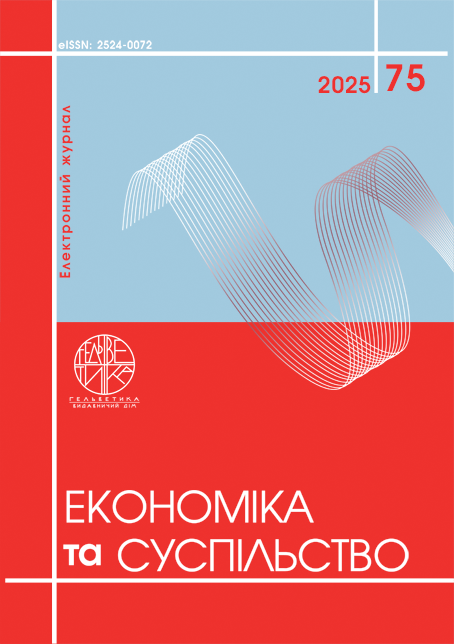THE SYSTEM OF SOLVENCY AND LIQUIDITY INDICATORS AND THEIR RELATIONSHIP WITH FINANCIAL STABILITY
Abstract
The article investigates the contemporary system of solvency and liquidity indicators and their multidimensional relationship with the financial stability of enterprises in the face of increased uncertainty and crisis conditions. The research analyses the dynamics of key financial ratios—including current, absolute, and quick liquidity, autonomy, and debt-to-equity—for leading Ukrainian industrial and trade companies during the pre-crisis, pandemic, and wartime periods from 2019 to 2022. The results demonstrate significant changes in financial management strategies, with enterprises exhibiting both declining liquidity and increased credit dependency as a response to crisis challenges. Particular attention is paid to the global trend of transitioning from classical balance-sheet analysis toward innovative cash-flow-based indicators, which enable dynamic diagnostics and more timely risk identification. The study conducts a comparative review of Ukrainian and international analytical approaches, drawing on experiences from Central Europe and Kosovo to reveal the adaptation of financial analysis methodologies and the revision of normative values under volatile conditions. The proposed author’s structural matrix and composite financial stability index synthesize liquidity, solvency, and cash-flow metrics, providing a scientifically grounded and practically relevant tool for integrated financial monitoring and scenario analysis. The article outlines practical recommendations for enterprises seeking to enhance the effectiveness of financial risk management and anti-crisis strategies through the combined use of classical and cash-flow indicators, the application of adaptive forecasting models, and the implementation of composite indices for real-time decision support. The proposed methodological approaches are intended to increase the financial resilience and competitiveness of Ukrainian enterprises in a rapidly changing environment.
References
Чеченєва М. Управління фінансовою стійкістю та платоспроможністю підприємств. Економіка та суспільство. 2024. № 54. С. 1–7. URL: https://economyandsociety.in.ua/index.php/journal/article/view/1758 (дата звернення: 11.06.2025).
Костенко Ю. О., Ковтун В. О., Гірман Л. М. Аналіз фінансової стійкості підприємства в умовах воєнного стану. Економіка та організація управління. 2023. № 4. С. 322–326. URL: https://economics.net.ua/ejopu/2023/No4/37.pdf (дата звернення: 11.06.2025).
Трач Р. М., Прокопчук Н. Я. Оцінка фінансової стійкості підприємства (на прикладі ДП «Антонов»). Економіка та суспільство. 2024. № 58. С. 1–8. URL: https://economyandsociety.in.ua/index.php/journal/article/view/3013/2935 (дата звернення: 11.06.2025).
Мельник Т. М., Гутник І. В. Ліквідність і платоспроможність підприємства та методи їх аналізу. Бізнес Інформ. 2023. № 4. С. 105–111. URL: https://www.business-inform.net/export_pdf/business-inform-2023-4_0-pages-105_111.pdf (дата звернення: 11.06.2025).
Zhang X., Chen X., Liu S., Tang G. Integrative Analysis of Traditional and Cash Flow Financial Ratios: Evidence from China. Sustainability. 2023. Vol. 15, No. 9. Article 7601. DOI: https://doi.org/10.3390/su15097601
Indah R. N., Kusumawati I., Rohmawati N., Setiyono J.Liquidity, Solvency, and Profitability Ratio Analysis as a Financial Performance Measurement Tool at PT Telkom Indonesia 2020–2022. International Journal of Economics, Business and Accounting Research. 2024. Vol. 8, Issue 2. С. 1355–1362. DOI: https://doi.org/10.29040/ijebar.v8i2.8761
Effendie M. I., Iman R., Rezkiana D., Nurpratiwi A., Asrori R. Analysis of the Effect of Liquidity Ratios, Solvency and Activity on the Financial Performance of the Company. International Journal of Social Science and Human Research. 2022. Vol. 05, Issue 03. С. 1072–1078. DOI: https://doi.org/10.47191/ijsshr/v5-i3-38
Abdulahi M., Lien B., Nguyen D. K., Schinckus C.Liquidity, solvency and profitability in Norwegian non-listed firms: An empirical investigation. Accounting & Finance. 2022. Vol. 62, Issue 3. С. 4123–4157. DOI: https://doi.org/10.1111/acfi.12919
Krasniqi, B. A., et al. (2022). Liquidity and Solvency Management and Their Impact on the Profitability of Businesses: The Case of Kosovo. International Journal of Economics and Business Administration, X(2), 17-27. URL: https://www.ijeba.com/journal/715/download (дата звернення: 11.06.2025)
Державна служба статистики України URL: https://stat.gov.ua/uk (дата звернення: 11.06.2025).
Checheneva M. (2024) Upravlinnia finansovoi stiikosti ta platospromozhnosti pidpryiemstv [Management of Financial Stability and Solvency of Enterprises]. Ekonomika ta suspilstvo – Economy and Society, no. 54, pp. 1–7. Available at: https://economyandsociety.in.ua/index.php/journal/article/view/1758 (accessed June 11, 2025).
Kostenko Yu. O., Kovtun V. O., Hirman L. M. (2023) Analiz finansovoi stiikosti pidpryiemstva v umovakh voiennoho stanu [Analysis of the Financial Stability of the Enterprise under Martial Law]. Ekonomika ta orhanizatsiia upravlinnia – Economics and Organization of Management, no. 4, pp. 322–326. Available at: https://economics.net.ua/ejopu/2023/No4/37.pdf (accessed June 11, 2025).
Trach R. M., Prokopchuk N. Ya. (2024) Otsinka finansovoi stiikosti pidpryiemstva (na prykladi DP «Antonov») [Assessment of Financial Stability of the Enterprise (Case of SE «Antonov»)]. Ekonomika ta suspilstvo – Economy and Society, no. 58, pp. 1–8. Available at: https://economyandsociety.in.ua/index.php/journal/article/view/3013/2935 (accessed June 11, 2025).
Melnyk T. M., Hutnyk I. V. (2023) Likvidnist i platospromozhnist pidpryiemstva ta metody yikh analizu [Liquidity and Solvency of the Enterprise and Methods of Their Analysis]. Biznec Inform - Business Inform, no. 4, pp. 105–111. Available at: https://www.business-inform.net/export_pdf/business-inform-2023-4_0-pages-105_111.pdf (accessed June 11, 2025).
Zhang X., Chen X., Liu S., Tang G. (2023) Integrative Analysis of Traditional and Cash Flow Financial Ratios: Evidence from China. Sustainability, vol. 15, no. 9, Article 7601. https://doi.org/10.3390/su15097601
Indah R. N., Kusumawati I., Rohmawati N., Setiyono J. (2024) Liquidity, Solvency, and Profitability Ratio Analysis as a Financial Performance Measurement Tool at PT Telkom Indonesia 2020–2022. International Journal of Economics, Business and Accounting Research, vol. 8, issue 2, pp. 1355–1362. https://doi.org/10.29040/ijebar.v8i2.8761.
Effendie M. I., Iman R., Rezkiana D., Nurpratiwi A., Asrori R. (2022) Analysis of the Effect of Liquidity Ratios, Solvency and Activity on the Financial Performance of the Company. International Journal of Social Science and Human Research, vol. 5, issue 3, pp. 1072–1078. https://doi.org/10.47191/ijsshr/v5-i3-38
Abdulahi M., Lien B., Nguyen D. K., Schinckus C. (2022) Liquidity, solvency and profitability in Norwegian non-listed firms: An empirical investigation. Accounting & Finance, vol. 62, issue 3, pp. 4123–4157. https://doi.org/10.1111/acfi.12919
Krasniqi B. A., et al. (2022) Liquidity and Solvency Management and Their Impact on the Profitability of Businesses: The Case of Kosovo. International Journal of Economics and Business Administration, vol. 10, no. 2, pp. 17–27. Available at: https://www.ijeba.com/journal/715/download
Derzhavna sluzhba statystyky Ukrainy [State Statistics Service of Ukraine]. Available at: https://stat.gov.ua/uk (accessed June 11, 2025).

This work is licensed under a Creative Commons Attribution 4.0 International License.


